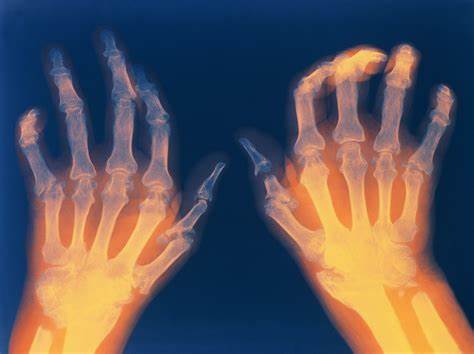The global rheumatoid arthritis drugs market size was valued at $57,929 million in 2019, and is projected to reach $62,935 million by 2027, registering a CAGR of 2.8% from 2020 to 2027.

Rheumatoid arthritis is a disease that causes pain and inflammation in joints. It affects individuals of all ages; however, the geriatric population is highly susceptible to develop this disease. The symptoms of rheumatoid arthritis include pain, stiffness, tender, and swelling of joints. Currently, no cure is available for rheumatoid arthritis. However, certain drugs are used to efficiently control the conditions of rheumatoid arthritis, which include disease-modifying anti-rheumatic drugs (DMARDs), nonsteroidal anti-inflammatory drugs (NSAIDs), corticosteroids, and uric acid drugs.
Rise in prevalence of rheumatoid arthritis, increase in demand for rheumatoid arthritis drugs, expiration of patents & the entry of biosimilar drugs, surge in geriatric population, increase in adoption of conventional DMARDs, and government initiatives toward spread in awareness for rheumatoid arthritis symptoms are the major factors that drive growth of the rheumatoid arthritis drugs market. In addition, innovations in advanced biologics, rise in healthcare expenditure, improvement in buying power, and access to quality drugs to poor & middle-class families globally are some other factors that contribute toward growth of the market. However, side effects associated with the medication and high costs of biological DMARD therapies are expected to act as the key restraints of the global market. On the contrary, rise in awareness related to early screening and treatment of rheumatoid arthritis is anticipated to offer high growth potential for the rheumatoid arthritis drugs market during the forecast period.
Rheumatoid Arthritis Drugs Market Size & Market Analysis
The World Health Organization (WHO) on January 30, 2020 declared COVID-19 outbreak a public health emergency of international concern. COVID-19 has affected around 210 countries across the globe. According to the Lancet Rheumatology 2020, patients with rheumatoid arthritis who develop COVID-19 infection may be at high risk for developing severe symptoms and additional complications. Some DMARDs commonly used to treat rheumatoid arthritis, such as hydroxychloroquine drug, are being investigated as potential therapy for COVID-19. Moreover, other generally used therapies such as biologics targeting interleukin (IL)-6 (sarilumab, tocilizumab) and IL-1 (anakinra) are being assessed in patients with COVID-19. Thus, COVID-19 infection uplifted growth opportunities for manufacturers of rheumatoid arthritis drugs during the forecast period.
Rheumatoid Arthritis Drugs Market Segmentation
The global rheumatoid arthritis drugs market is segmented into drug class, route of administration, sales channel, and region. Depending on drug class, the market is categorized into disease-modifying anti-rheumatic drugs (DMARDs), nonsteroidal anti-inflammatory drugs (NSAIDs), corticosteroids, uric acid drugs, and others. By route of administration, it is segregated into oral and parenteral. On the basis of sales channel, it is fragmented into prescription-based drugs and over-the-counter drugs. Region wise, the market is analyzed across North America, Europe, Asia-Pacific, and LAMEA.
Presently, on the basis of drug class, the disease-modifying anti-rheumatic drugs (DMARDs) is the major revenue contributor, and is projected to grow significantly during the forecast period. Rise in awareness related to the use of DMARDs, surge in prevalence of rheumatoid arthritis, rise in obese & overweight population across the globe, and increase in adoption of DMARDs as a first-line treatment for rheumatoid arthritis are the key factors that boost growth of the segment.
Depending on sales channel, the prescription-based drugs segment is the major shareholder in the global rheumatoid arthritis drugs market, owing to advantages offered by prescription-based drugs such as patients gets the correct dosage of the drug during the treatment of rheumatoid arthritis, without causing any side effects, and it prevents the potential scope of drug misuse. However, the OTC drugs segment is expected to exhibit the fastest growth rate during the forecast period, owing to convenience of direct purchase and increase in innovations & developments in OTC drugs.
Asia-Pacific presents lucrative opportunities for key players operating in the rheumatoid arthritis drugs market, owing to the presence of large population base susceptible to rheumatoid arthritis, increase in public awareness toward use & benefits of these drugs, development of the R&D sector, rise in healthcare reforms, and increase in adoption of rheumatoid arthritis drugs. Moreover, increase in demand for DMARDs and rise in geriatric population contribute toward growth of the market. Moreover, surge in focus of leading manufacturers on expanding their geographical presence in emerging Asia-Pacific countries to capture high rheumatoid arthritis drugs market share is expected to drive growth of the market in the region.
The key players profiled in this report include AbbVie Inc., Amgen Inc., Bristol-Myers Squibb Company, Eli Lilly and Company, F. Hoffmann-La Roche Ltd, Johnson & Johnson, Merck & Co., Inc., Novartis AG, Pfizer Inc., and UCB S.A.
Rheumatoid Arthritis Drugs Market Size & Market Analysis
Source : https://www.alliedmarketresearch.com/rheumatoid-arthritis-RA-drugs-market
